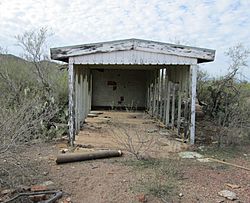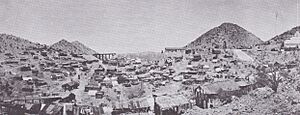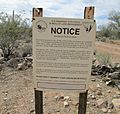Silver Bell, Arizona facts for kids
Quick facts for kids
Silver Bell, Arizona
|
|
|---|---|

A ruin in Silver Bell.
|
|
| Country | United States |
| State | Arizona |
| County | Pima |
| Time zone | UTC-7 (MST (no DST)) |
| Post Office opened | August 18, 1904 |
Silver Bell is a ghost town located in the Silver Bell Mountains in Pima County, Arizona. A ghost town is a place that used to be a busy community but is now mostly empty.
There were actually two towns named Silver Bell. The first one, called "Silverbell," started in 1904 and was left empty by the early 1930s. A newer town, named "Silver Bell," was built in 1954 and also became a ghost town by 1984. Both towns grew because people were mining for copper nearby. When the mining stopped, the towns were no longer needed.
A book called Ghost Towns of Arizona described the first Silverbell as a very famous mining camp. Today, almost nothing is left of the original town except for a cemetery. The newer Silver Bell town also has only a few small ruins left.
Contents
The Story of Silverbell
Early Mining Days
Mining in the Silver Bell Mountains has a long and interesting history. It was often complicated because the copper business changed a lot in the late 1800s and early 1900s. People were mostly interested in finding copper, but they also mined for silver, lead, and gold.
The first time people officially started looking for minerals was in the early 1870s. A man named Charles O. Brown from Tucson led the way. By 1874, he and his partners had opened some mines and even a smelter, which is a place where metal is melted to separate it from rock.
Other mines were started later, like the Atlas and Old Boot mines. Many different groups and companies tried to make them work. Back then, miners often created their own "mining districts" to set rules and boundaries. This happened because there wasn't much government control in the American West.
Growing the Town
Around 1900, it became clear that combining all the mining claims would be the best way to make money. Two businessmen, Zeckendorf and Steinfeld, bought many claims, including the very productive Old Boot mine. Another company, the Oxide Copper Company, owned the Young America mine.
By 1901, there were enough families in the area that Pima County opened a public school. It had 75 students that year! Two small communities were counted in the 1900 census: Peltonville had 80 people, and Atlas Camp had 59.
In 1903, Zeckendorf and his partners sold their claims to the Imperial Copper Company. This company worked hard to develop the mines. By 1904, they even built their own railroad, the Arizona Southern Railroad, to carry copper from Silverbell to Red Rock. They also built a smelter in Sasco and an electrical power plant to power the mines and towns.
Life in Silverbell
Soon after it started, the Imperial Copper Company built the town of Silverbell. By 1905, about 1,000 people lived there. The town had a post office, company offices, a Wells Fargo station, a company store, and a school. There were also two saloons, a Chinese bakery, a barber, a doctor, and a deputy sheriff.
By 1907, the town had even more services, like a company hotel, a cobbler (someone who fixes shoes), and more bakeries. A dairy and a public notary (someone who can legally witness signatures) arrived by 1909. A local businessman, E. Glen Baker, opened a saloon, a general store, a billiard parlor, and even an auto stage (an early bus service).
One big problem for Silverbell was getting enough clean drinking water. The local water had too many minerals and couldn't be used for drinking or even gardening. Drinking water had to be brought in, first by mules and wagons, and later by train. It was stored in tanks and sold to people twice a day from two taps. Sometimes, guards even watched the taps! People sometimes left their jobs because they couldn't get good drinking water.
Despite this, the town grew for a short time. In 1910, the census showed 1,118 people living in Silverbell. There were many women and hundreds of children. People from different backgrounds lived there, including American, Mexican, O'odham, Chinese, and Japanese individuals. However, the community was separated by groups.
Other jobs in town included grocers, butchers, restaurant owners, teachers, carpenters, and even a photographer. The company also had a hospital. Around 1910, two firehouses and a movie house were added. But by 1911, many private businesses seemed to leave, likely because the Imperial company was having problems.
Changes and Decline
The Imperial Copper Company faced financial trouble and had to lease its mines to Asarco in 1911. Asarco eventually bought all of Imperial's assets by 1919. Under Asarco, Silverbell became the company's main office and a community for workers again. The population grew back to 1,200 people in 1920.
However, this comeback didn't last long. After the price of copper dropped in 1920, Asarco focused on other mines. They completely stopped mining in the Silver Bell District by 1930. The town's population quickly dropped. By 1931, only about 45 people lived in Silverbell. The railroad that brought supplies and mail was taken apart and sold in 1933. The post office closed for good in 1934.
Sheriff Sam McEven
Sam McEven was the deputy in Silverbell. He was known for making the old town a safer place. People say that three men were killed in Silverbell in the three days before McEven arrived!
When he first got there, McEven spent months arresting people for carrying hidden weapons. He would fine them or put them in jail.
One time, a miner named Ramon Castro killed another man and hid in an old mine shaft for two weeks. It was McEven's job to catch him. McEven knew it would be dangerous to go into the shaft without protection. So, he came up with a clever plan: He got an ore car (a small cart used in mines), hung a lamp on it, and pushed this "bulletproof" barrier in front of him. He pushed the car through the mine shaft until he found and captured Castro.
The Newer Silver Bell
Asarco continued to do well and bought more mining claims in the area. In 1952, Asarco started using a new method called open pit mining, which involves digging a large hole in the ground. In 1954, they built a brand new town, also called Silver Bell, about four miles southeast of the original site.
This new Silver Bell town lasted from 1952 until 1984. When copper prices dropped again and the town's water and sewer systems started to break down, the mining operations stopped in 1984. The town was then closed. Most of the homes were sold and moved to other places near Tucson. Today, only a few small ruins remain, like a garage that belonged to the General Manager. This is the "ruin" you see pictured at the top of this article.
In 1989, Asarco bought another old mine called the BS&K Mine. It's near the original Silverbell site in Ironwood Forest. Today, you can still see a few old buildings, some mine shafts, and wrecked vehicles there.
Images for kids
-
A Bureau of Land Management cultural resources sign at the Silver Bell Cemetery.

















